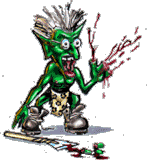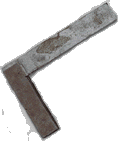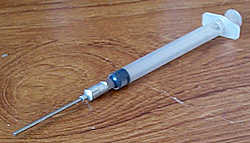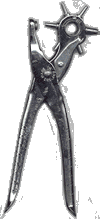Modelling Tools
Cutting Tools, Brushes, Miscellaneous Tools,


CUTTING TOOLS
 Scalpel
Scalpel

 The
best tool for most of your cutting needs is a surgical scalpel. They come
with detachable blades which can be easily changed when they become blunt.
A good blade shape is the 10a, which has a sharp point and a flat
cutting edge, but a number of types are available including curved blades.
Don't lean on the knife too hard when cutting, or you will snap the blade.
The
best tool for most of your cutting needs is a surgical scalpel. They come
with detachable blades which can be easily changed when they become blunt.
A good blade shape is the 10a, which has a sharp point and a flat
cutting edge, but a number of types are available including curved blades.
Don't lean on the knife too hard when cutting, or you will snap the blade.
WARNING Be extremely careful, you can cut big pieces
out of yourself in an instant. The easiest way to cut yourself is when
cutting against a steel rule. If the fingers of the hand holding the
ruler stick over the edge, you will neatly slice the ends off. During
my architecture course, countless people did exactly that (including
myself - twice) and one had to go to casualty to have it bandaged.
Usefulness - Essential
Availability - Very Common
Sources - Model, craft & art shops.
 Craft Knife
Craft Knife

 If you want to hack through solid bits of wood or large chunks of figure, you will need something heavier than a scalpel.
This one is an 'X-acto' knife and has more in common with a chisel than a craft knife. It has interchangeable blades
which are strong enough to be exceptionally difficult to break.
If you want to hack through solid bits of wood or large chunks of figure, you will need something heavier than a scalpel.
This one is an 'X-acto' knife and has more in common with a chisel than a craft knife. It has interchangeable blades
which are strong enough to be exceptionally difficult to break.
You could also use a 'Stanley' knife, the traditional craft knife, but I wouldn't recommend the ones with the long
segmented blades that you break off to get a fresh edge. They are probably fine if you get a good one, but the two I've had
have broken.
Usefulness - Very Useful
Availability - Common
Sources - Model, craft & art shops.
 Steel Set Square
Steel Set Square

 This
can be used to get a precise right angle when cutting walls for buildings
and similar. The one shown here is about 4" long.
This
can be used to get a precise right angle when cutting walls for buildings
and similar. The one shown here is about 4" long.
Usefulness - Fairly Useful
Availability - Rare
Sources - Craft, model and hardware shops.
 Metal Rule
Metal Rule

Use this and a scalpel to cut a straight line through card, paper etc. Aluminium ones are
better than steel because they don't rust. Some have a rubbery strip stuck
underneath which prevents whatever you are cutting from slipping.
Usefulness - Very Useful
Availability - Common
Sources - DIY, craft and hardware shops.
 Small Metal Rule
Small Metal Rule

This one is only 6" long, which makes it very easy to position and
turn. It is ideal for fiddly stuff like cutting out windows from bits of card
etc. The thinness of the metal has the added bonus that when you press it down,
it bends over things you are cutting which helps to stop them slipping. You
will need a larger rule as well for cutting bigger items, but this makes a handy
alternative. I got this one for only 50 pence from a market stall.

Usefulness - Handy
Availability - Fairly Rare
Sources - DIY, craft and hardware shops.
BRUSHES
Brushes are very much a personal thing, so I will just describe what I use.
 Figure Painting Brushes
Figure Painting Brushes

I use a size 2. Prolene brush from Pro Arte. This is a mixture of synthetic and natural hair, which I find lasts better than pure sable. It keeps a good point, so you don't need anything smaller. When they get old, I shorten them slightly with a pair of scissors, and use them for drybrushing.
Usefulness - Essential
Availability - Very Common
Sources - DIY, craft and model shops.
 Scenery Brushes
Scenery Brushes

I have a size 7 and a size 11 'Dalon' brush from Daler. These don't keep a point, but will stand
an awful lot of abuse in the form of glue and dry brushing.
Usefulness - Essential
Availability - Very Common
Sources - DIY, craft and model shops.
MISCELLANEOUS TOOLS
 Pliers
Pliers

The most useful kind is one with narrow tips (needle pliers), make
sure you get some with a wire cutting bit at the back. You can get some really
tiny ones which are designed for working on jewellery.
Usefulness - Very Useful
Availability - Common
Sources - DIY, craft and model shops.
 Hypodermic
Hypodermic

 I
use this blunt nozzled hypodermic for adding water to paintpots, occasionally
squirting in a couple of syringefuls and giving it a stir can add years to their
life. Brushes don't hold enough water, taps are inconvenient and easy to flood
with, and pouring is messy. Laboratory pipettes would also be good. It's best
to keep a container of clean water for this, and not to use brush washing water.
I
use this blunt nozzled hypodermic for adding water to paintpots, occasionally
squirting in a couple of syringefuls and giving it a stir can add years to their
life. Brushes don't hold enough water, taps are inconvenient and easy to flood
with, and pouring is messy. Laboratory pipettes would also be good. It's best
to keep a container of clean water for this, and not to use brush washing water.
Usefulness - Occasionally Convenient
Availability - Rare
Sources - ?
 Tweezers
Tweezers

Nice for positioning those minute and awkward bits of model.
Usefulness - Very Useful
Availability - Common
Sources - Craft and cosmetic shops.
 Punch Pliers
Punch Pliers

 These are used to punch small holes in things, and are usually used for
making holes in the leather of horse riding equipment.
These are used to punch small holes in things, and are usually used for
making holes in the leather of horse riding equipment.
Unfortunately when used on card, the
tubes tend to jam up, so you will need to unblock them regularly with
a thin piece of metal.
|
Usefulness - Occasionally Useful
Availability - Rare
Sources - Riding tack and some craft shops.
 Metal Pointy Thing
Metal Pointy Thing


This is a steel spike about 78" long with a round spatula on one end. I think
it is some kind of leatherworking tool. I use it for all sorts of things,
such as unblocking glue tubes, stirring paint, making holes and round dents
in things etc.
Unfortunately I can't say where it came from, because I don't know. As far
as I remember my Dad found it somewhere and thought it might be useful. I
have a feeling that it might have been his grandfather's.
Usefulness - Fairly Useful
Availability - Might be unique
Sources - Who knows
 Clay-shaping tool
Clay-shaping tool


Again I'm not sure where this came from, but it is a fairly typical clay
working tool. It can also be used to shape epoxy putty, although personally
I tend to use a scalpel.
This one is brass, but you are more likely to get them in plastic these days.
Usefulness - Useful for putty modelling
Availability - Fairly rare
Sources - Craft and art shops
 Clothes Pegs
Clothes Pegs (or Clothes Pins in America)

Use these to firmly clamp bits of card etc. when waiting for the glue to dry.
Usefulness - Very Useful
Availability - Common
Sources - Hardware shops.



 The
best tool for most of your cutting needs is a surgical scalpel. They come
with detachable blades which can be easily changed when they become blunt.
A good blade shape is the 10a, which has a sharp point and a flat
cutting edge, but a number of types are available including curved blades.
Don't lean on the knife too hard when cutting, or you will snap the blade.
The
best tool for most of your cutting needs is a surgical scalpel. They come
with detachable blades which can be easily changed when they become blunt.
A good blade shape is the 10a, which has a sharp point and a flat
cutting edge, but a number of types are available including curved blades.
Don't lean on the knife too hard when cutting, or you will snap the blade.
 This
can be used to get a precise right angle when cutting walls for buildings
and similar. The one shown here is about 4" long.
This
can be used to get a precise right angle when cutting walls for buildings
and similar. The one shown here is about 4" long.
 I
use this blunt nozzled hypodermic for adding water to paintpots, occasionally
squirting in a couple of syringefuls and giving it a stir can add years to their
life. Brushes don't hold enough water, taps are inconvenient and easy to flood
with, and pouring is messy. Laboratory pipettes would also be good. It's best
to keep a container of clean water for this, and not to use brush washing water.
I
use this blunt nozzled hypodermic for adding water to paintpots, occasionally
squirting in a couple of syringefuls and giving it a stir can add years to their
life. Brushes don't hold enough water, taps are inconvenient and easy to flood
with, and pouring is messy. Laboratory pipettes would also be good. It's best
to keep a container of clean water for this, and not to use brush washing water.
 These are used to punch small holes in things, and are usually used for
making holes in the leather of horse riding equipment.
These are used to punch small holes in things, and are usually used for
making holes in the leather of horse riding equipment.